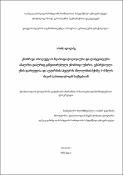Options
ენობრივი პროდუქციის ნეიროფსიქოლოგიური და ლინგვისტური ანალიზი ტიპურად განვითარებული ენობრივი უნარის, ექსპრესიული ენის დარღვევისა და აუტიზმის სპექტრის აშლილობის მქონე 4-6 წლის ასაკის ქართულენოვან ბავშვებთან
Date Issued
2022
Author(s)
Advisor(s)
Abstract
The aim of the study was to make comparison of language output among Georgian language-speaking children at the age of 4-6 with typically developed language skills, language disorder and autism spectrum disorder according to language components (phonology, semantics, syntax, morphology and pragmatics) and typology of verbal behavior (“mand”, “tact”, “echoic”, “intraverbal”). The results obtained were explained within different cognitive models of language.
Based on the data obtained from the study, it can be said that all three of these groups basically do not differ from each other in the tendency to use parts of speech. Taking into consideration the linguistic peculiarity of the Georgian language, they use the members of the sentence more frequently, whose roles are leading in the process of content delivery. Due to linguistic errors phonetic difficulties are a typical error in children with language disorder, while in the case of the autism spectrum the typical error is related to pragmatic problems. The length of sentences said by children with typical language abilities and language disorder exceeds the data of children with autism spectrum disorder in both formal and informal situations. The use of “mand” and “echoic” is mostly characteristic to children with autism spectrum disorder. Intraverbal is applied with similar success by both children with typical language abilities and language disorder. Harping on a topic of narrow interest and intonated speech is a typical feature for children with autism spectrum disorder and they are rarely met with the other two groups. The use of word equivalents is characteristic only to the group with language disorder. Within the frame of Levelt’s cognitive model of language, the difference between the groups is the following: For language disorder, the problematic stage may be the step of formulation, grammatical and phonological coding, and the articulation of an additional phonetic plan. In the case of the autism spectrum, the main language difficulty is the step of conceptualization, response preparation and monitoring, the consideration of previous verbal response and word formulation in compliance with it and grammatical coding.
Based on the data obtained from the study, it can be said that all three of these groups basically do not differ from each other in the tendency to use parts of speech. Taking into consideration the linguistic peculiarity of the Georgian language, they use the members of the sentence more frequently, whose roles are leading in the process of content delivery. Due to linguistic errors phonetic difficulties are a typical error in children with language disorder, while in the case of the autism spectrum the typical error is related to pragmatic problems. The length of sentences said by children with typical language abilities and language disorder exceeds the data of children with autism spectrum disorder in both formal and informal situations. The use of “mand” and “echoic” is mostly characteristic to children with autism spectrum disorder. Intraverbal is applied with similar success by both children with typical language abilities and language disorder. Harping on a topic of narrow interest and intonated speech is a typical feature for children with autism spectrum disorder and they are rarely met with the other two groups. The use of word equivalents is characteristic only to the group with language disorder. Within the frame of Levelt’s cognitive model of language, the difference between the groups is the following: For language disorder, the problematic stage may be the step of formulation, grammatical and phonological coding, and the articulation of an additional phonetic plan. In the case of the autism spectrum, the main language difficulty is the step of conceptualization, response preparation and monitoring, the consideration of previous verbal response and word formulation in compliance with it and grammatical coding.
Degree Name
PhD in Psychology
Degree Discipline
Educational Psychology
File(s)
Loading...
Name
Irina Dogadze-sadoktoro.pdf
Description
ენობრივი პროდუქციის ნეიროფსიქოლოგიური და ლინგვისტური ანალიზი ტიპურად განვითარებული ენობრივი უნარის, ექსპრესიული ენის დარღვევისა და აუტიზმის სპექტრის აშლილობის მქონე 4-6 წლის ასაკის ქართულენოვან ბავშვებთან
Size
3.36 MB
Format
Adobe PDF
Checksum
(MD5):a33028ee58f0dd639111914cefae74c3
No Thumbnail Available
Name
ი. დოღაძე - დასკვნა პლაგიატზე.pdf
Description
ანტიპლაგიატი
Size
4.55 MB
Format
Adobe PDF
Checksum
(MD5):27f7069a71cac4e1194b162e478908a0